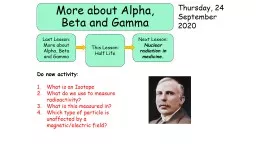

Thursday 24 September 2020 Do now activity What is an Isotope What do we use to measure radioactivity What is this measured in Which type of particle is unaffected by a magneticelectric field ID: 911704
Download Presentation The PPT/PDF document "More about Alpha, Beta and Gamma" is the property of its rightful owner. Permission is granted to download and print the materials on this web site for personal, non-commercial use only, and to display it on your personal computer provided you do not modify the materials and that you retain all copyright notices contained in the materials. By downloading content from our website, you accept the terms of this agreement.
Slide1
More about Alpha, Beta and Gamma
Thursday, 24 September 2020
Do now activity
:What is an IsotopeWhat do we use to measure radioactivity?What is this measured in?Which type of particle is unaffected by a magnetic/electric field?
This Lesson:Half Life
Last Lesson:More about Alpha, Beta and Gamma
Next Lesson: Nuclear radiation in medicine.
Slide2GOOD PROGRESS:-
State the 3 definitions of half-life- Find the half-life of a substance from a graph / Plot a graph showing the decay of a sample and use it to determine half life.OUTSTANDING PROGRESS:
- Calculate the changes in count rate or nuclei remaining.
Progress indicators
Slide3Atoms of the same element but a different number of neutrons than protons
The number of protons and neutrons is indicated by A which is also the mass number
X
AZ
Isotopes
Slide4Activity vs Count Rate
Radioactive
Source
Activity
Count Rate
2D
3D
Count Rate is the number of counts per second from a Geiger Counter at the imaginary surface of the cone of the sphere projected out from the centre of the radioactive source.
Slide5Calculating Activity and Count Rate of an Un-Stable Radioactive Isotope.
Activity:
Number of atoms that decay per second from the nucleus
Activity = Number of Atoms that Decayed Time (s)Count Rate:Number of counts per second from a Geiger CounterCount Rate = Number of counts from Geiger Counter
Time (s)
Slide6Count Rate over Time
20
40
60
80
100
140
120
160
180
200
45
30
15
105
75
90
60
120
135
150
Count Rate
Time (mins)
Example radioisotope
0
0
Slide7Half Life – Count Rate
Count Rate
Time (mins)
2000
1003050
6025
9012.5120
6.25
1503.125
180
Count Rate Measurements over time
Time (mins)
Count Rate
Slide8Half Life – Count Rate
Count Rate
Count Rate Diff.
Time (mins)Time Interval (mins)2000
100=2002303050
=1002603025
=502903012.5
=25212030
6.25=12.52
150
30
3.125
=6.25
2
180
30
Count Rate Measurements over time
Time (mins)
Count Rate
Slide9Pattern:
Every 30mins the count rate reduces by half of the previous count rate
Half Life – Definition 1:
The average time taken for the count rate to reduce to half of its initial (previous) valueHalf life - Definition
Slide10Half life from a graph
Time (mins)
Count Rate
T1
T2
T3
T2
-
T1
= Half Life
To Check:
T3
–
T2
= Half Life
C1
2 =
C2
C1
C2
2 =
C3
1
2
3
4
5
6
7
8
Should be
roughly
the same
Complete the Worksheet on calculating Graphical Half Life
Slide11Reminder Half Life – Definition 2:
The
average time taken for the number of un-stable radioactive isotope nuclei to half in number.
Half Life – Definition 3:The average time taken for the mass of un-stable radioactive isotope atoms to half in mass.Half life - Definition
Slide12Task
What’s the difference between Activity and Count Rate?
What are the three definitions of Half Life?
The average time taken for the count rate to reduce to half of its initial (previous) valueThe average time taken for the number of un-stable radioactive isotope nuclei to half in numberThe average time taken for the mass of un-stable radioactive isotope atoms to half in mass
Activity is the total number of all atoms that decay per second.Count Rate is the number of counts per second from a Geiger Counter at a particular point from the source of the radioactivity
Slide13The half-life of a material is 3 hours. If the initial count rate is 544
Bq
, what will the count rate be after 15 hours?
We are told that the half-life of the material is 3 hours.In 15 hours there are 5 iterations of the half life (15 ÷ 3 = 5).After each half-life the count rate is halved.
Calculating Half Life
Slide14Calculating Half Life
Notes
Count Rate
(Bq)
Number of Half Lives
Starting Count Rate = 554
554
554 ÷ 2 = 272
272
1
272 ÷ 2 = 136
136
2
136 ÷ 2 = 68
68
3
68 ÷ 2 = 34
34
4
34 ÷2 =17
17
5
5 steps of 3 hours each
Answer: That after five half-lives the count rate is 17
Bq
.